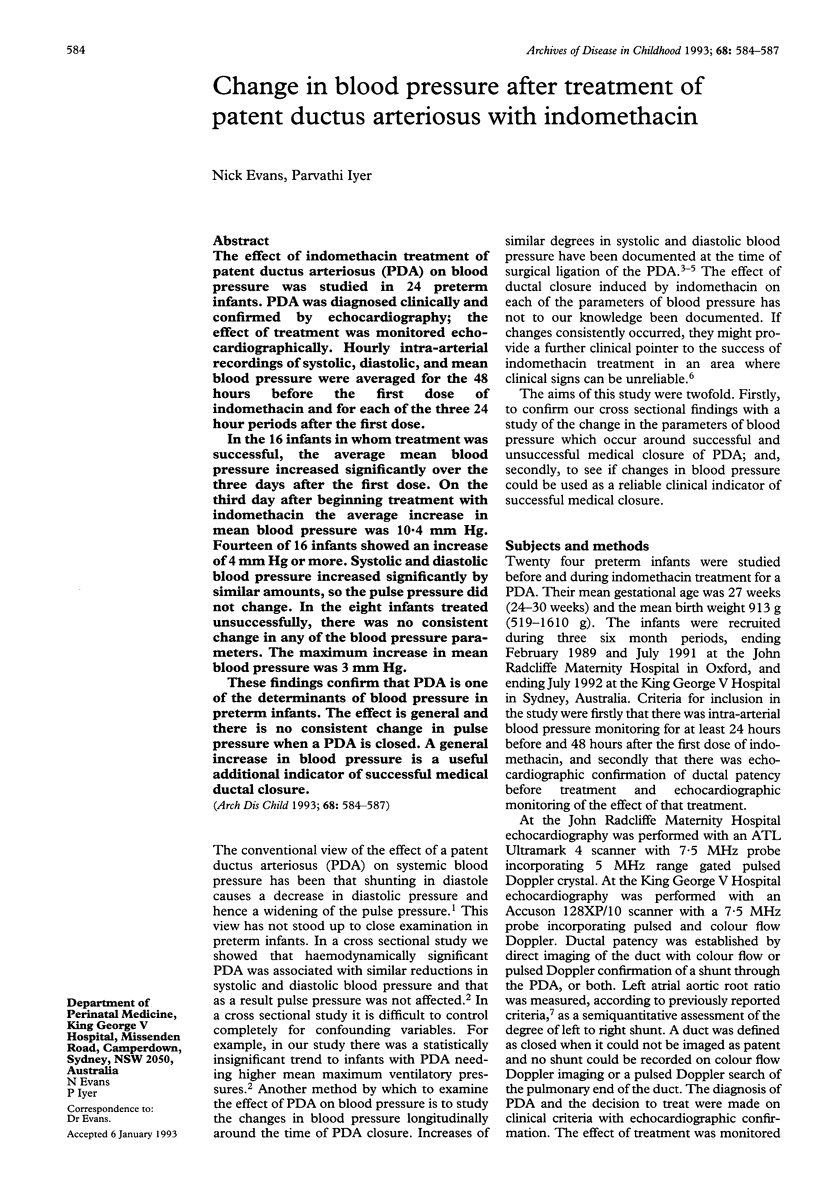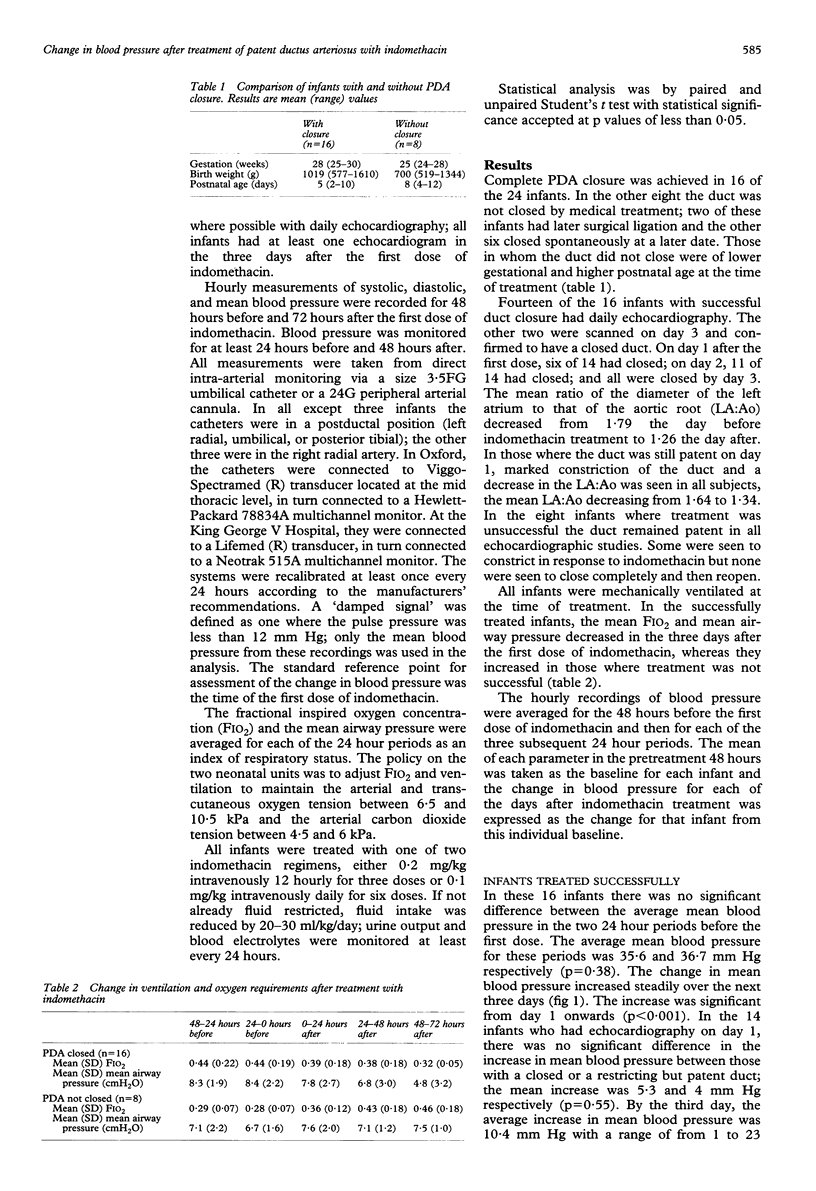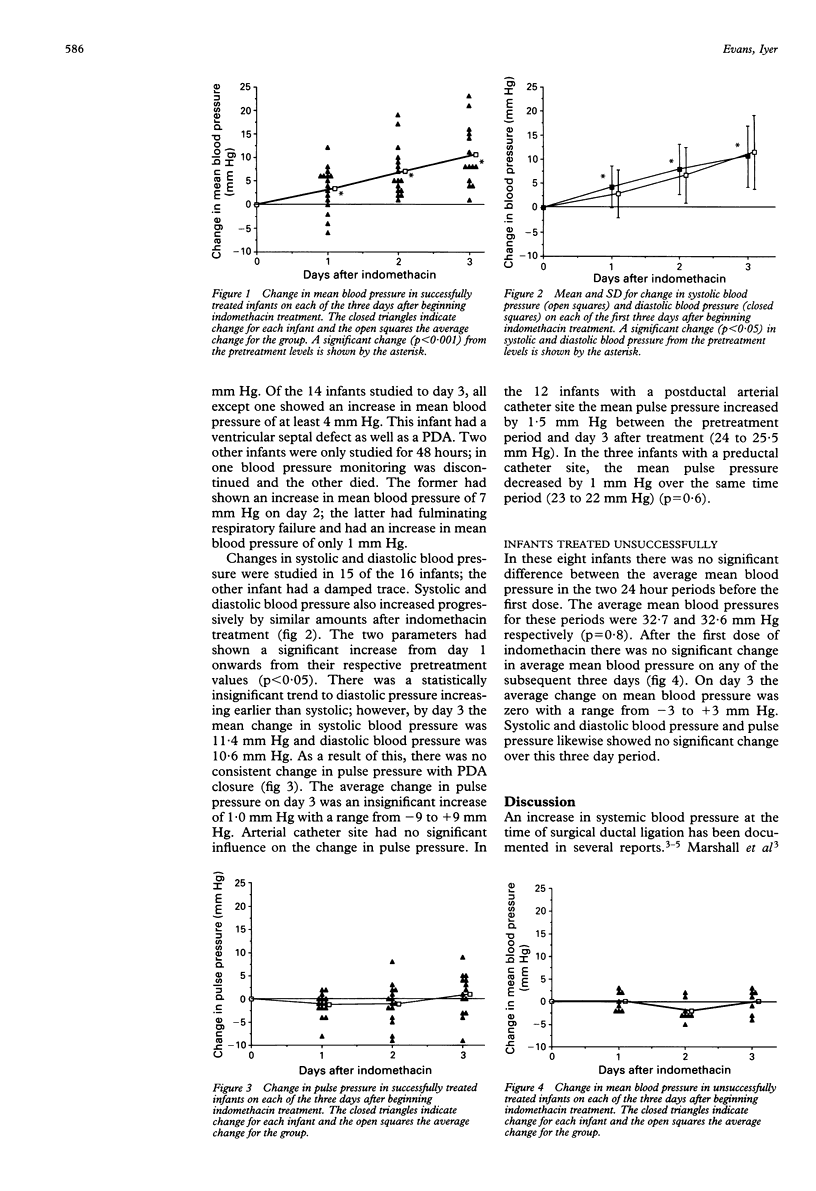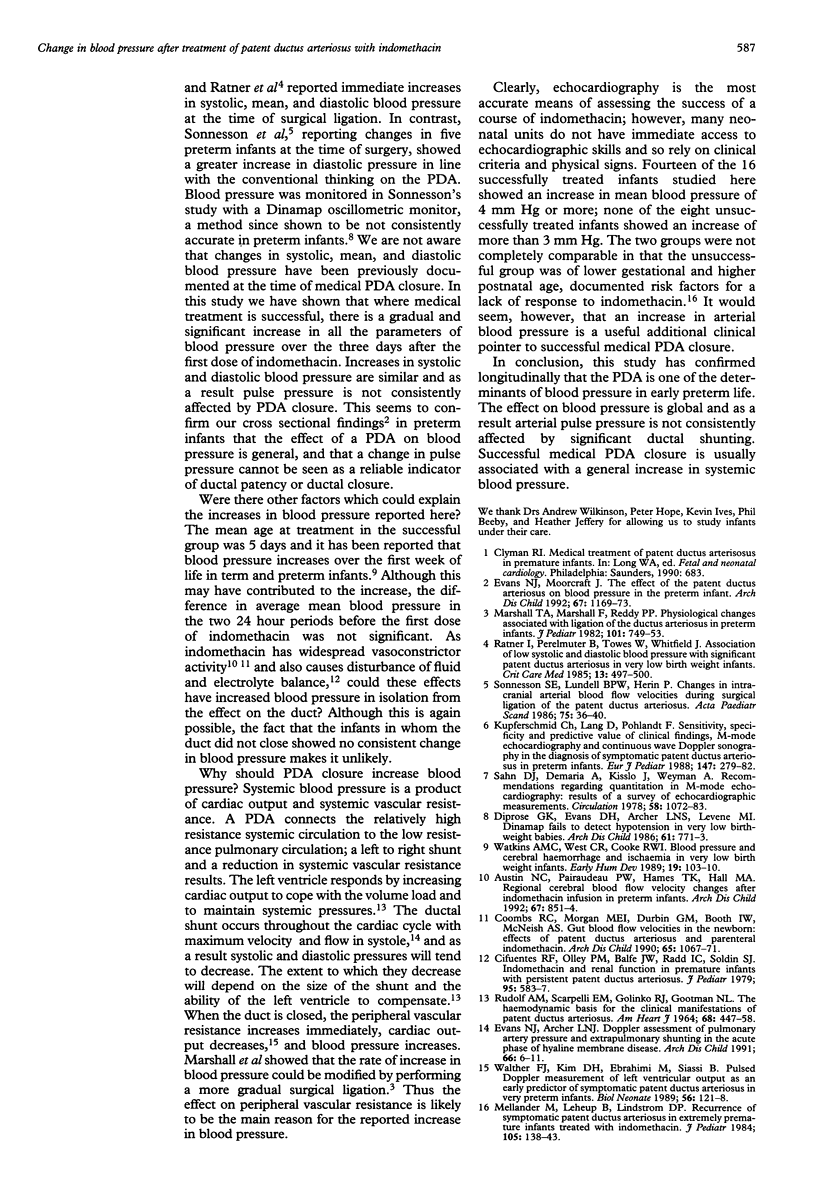Abstract
The effect of indomethacin treatment of patent ductus arteriosus (PDA) on blood pressure was studied in 24 preterm infants. PDA was diagnosed clinically and confirmed by echocardiography; the effect of treatment was monitored echocardiographically. Hourly intra-arterial recordings of systolic, diastolic, and mean blood pressure were averaged for the 48 hours before the first dose of indomethacin and for each of the three 24 hour periods after the first dose. In the 16 infants in whom treatment was successful, the average mean blood pressure increased significantly over the three days after the first dose. On the third day after beginning treatment with indomethacin the average increase in mean blood pressure was 10.4 mm Hg. Fourteen of 16 infants showed an increase of 4 mm Hg or more. Systolic and diastolic blood pressure increased significantly by similar amounts, so the pulse pressure did not change. In the eight infants treated unsuccessfully, there was no consistent change in any of the blood pressure parameters. The maximum increase in mean blood pressure was 3 mm Hg. These findings confirm that PDA is one of the determinants of blood pressure in preterm infants. The effect is general and there is no consistent change in pulse pressure when a PDA is closed. A general increase in blood pressure is a useful additional indicator of successful medical ductal closure.
Full text
PDF



Selected References
These references are in PubMed. This may not be the complete list of references from this article.
- Austin N. C., Pairaudeau P. W., Hames T. K., Hall M. A. Regional cerebral blood flow velocity changes after indomethacin infusion in preterm infants. Arch Dis Child. 1992 Jul;67(7 Spec No):851–854. doi: 10.1136/adc.67.7_spec_no.851. [DOI] [PMC free article] [PubMed] [Google Scholar]
- Cifuentes R. F., Olley P. M., Balfe J. W., Radde I. C., Soldin S. J. Indomethacin and renal function in premature infants with persistent patent ductus arteriosus. J Pediatr. 1979 Oct;95(4):583–587. doi: 10.1016/s0022-3476(79)80775-1. [DOI] [PubMed] [Google Scholar]
- Coombs R. C., Morgan M. E., Durbin G. M., Booth I. W., McNeish A. S. Gut blood flow velocities in the newborn: effects of patent ductus arteriosus and parenteral indomethacin. Arch Dis Child. 1990 Oct;65(10 Spec No):1067–1071. doi: 10.1136/adc.65.10_spec_no.1067. [DOI] [PMC free article] [PubMed] [Google Scholar]
- Diprose G. K., Evans D. H., Archer L. N., Levene M. I. Dinamap fails to detect hypotension in very low birthweight infants. Arch Dis Child. 1986 Aug;61(8):771–773. doi: 10.1136/adc.61.8.771. [DOI] [PMC free article] [PubMed] [Google Scholar]
- Evans N. J., Archer L. N. Doppler assessment of pulmonary artery pressure and extrapulmonary shunting in the acute phase of hyaline membrane disease. Arch Dis Child. 1991 Jan;66(1 Spec No):6–11. doi: 10.1136/adc.66.1_spec_no.6. [DOI] [PMC free article] [PubMed] [Google Scholar]
- Evans N., Moorcraft J. Effect of patency of the ductus arteriosus on blood pressure in very preterm infants. Arch Dis Child. 1992 Oct;67(10 Spec No):1169–1173. doi: 10.1136/adc.67.10_spec_no.1169. [DOI] [PMC free article] [PubMed] [Google Scholar]
- Kupferschmid C., Lang D., Pohlandt F. Sensitivity, specificity and predictive value of clinical findings, m-mode echocardiography and continuous-wave Doppler sonography in the diagnosis of symptomatic patent ductus arteriosus in preterm infants. Eur J Pediatr. 1988 Apr;147(3):279–282. doi: 10.1007/BF00442695. [DOI] [PubMed] [Google Scholar]
- Marshall T. A., Marshall F., 2nd, Reddy P. P. Physiologic changes associated with ligation of the ductus arteriosus in preterm infants. J Pediatr. 1982 Nov;101(5):749–753. doi: 10.1016/s0022-3476(82)80311-9. [DOI] [PubMed] [Google Scholar]
- Mellander M., Leheup B., Lindstrom D. P., Palme C., Graham T. P., Jr, Stahlman M. T., Cotton R. B. Recurrence of symptomatic patent ductus arteriosus in extremely premature infants, treated with indomethacin. J Pediatr. 1984 Jul;105(1):138–143. doi: 10.1016/s0022-3476(84)80380-7. [DOI] [PubMed] [Google Scholar]
- RUDOLPH A. M., SCARPELLI E. M., GOLINKO R. J., GOOTMAN N. L. HEMODYNAMIC BASIS FOR CLINICAL MANIFESTATIONS OF PATENT DUCTUS ARTERIOSUS. Am Heart J. 1964 Oct;68:447–458. doi: 10.1016/0002-8703(64)90145-0. [DOI] [PubMed] [Google Scholar]
- Ratner I., Perelmuter B., Toews W., Whitfield J. Association of low systolic and diastolic blood pressure with significant patent ductus arteriosus in the very low birth weight infant. Crit Care Med. 1985 Jun;13(6):497–500. doi: 10.1097/00003246-198506000-00012. [DOI] [PubMed] [Google Scholar]
- Sahn D. J., DeMaria A., Kisslo J., Weyman A. Recommendations regarding quantitation in M-mode echocardiography: results of a survey of echocardiographic measurements. Circulation. 1978 Dec;58(6):1072–1083. doi: 10.1161/01.cir.58.6.1072. [DOI] [PubMed] [Google Scholar]
- Sonesson S. E., Lundell B. P., Herin P. Changes in intracranial arterial blood flow velocities during surgical ligation of the patent ductus arteriosus. Acta Paediatr Scand. 1986 Jan;75(1):36–42. doi: 10.1111/j.1651-2227.1986.tb10154.x. [DOI] [PubMed] [Google Scholar]
- Walther F. J., Kim D. H., Ebrahimi M., Siassi B. Pulsed Doppler measurement of left ventricular output as early predictor of symptomatic patent ductus arteriosus in very preterm infants. Biol Neonate. 1989;56(3):121–128. doi: 10.1159/000243112. [DOI] [PubMed] [Google Scholar]
- Watkins A. M., West C. R., Cooke R. W. Blood pressure and cerebral haemorrhage and ischaemia in very low birthweight infants. Early Hum Dev. 1989 May;19(2):103–110. doi: 10.1016/0378-3782(89)90120-5. [DOI] [PubMed] [Google Scholar]


